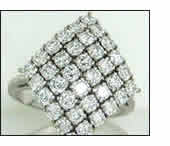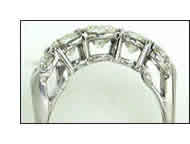Jewelry Workmanship
Contrary to popular belief, the vast majority of jewelry is not "one of a kind." Today's fine jewelry is usually machine-processed in some way. Modern methods have eliminated much of the time-consuming handwork, making fine jewelry accessible to more people.
Cast
 Cast
jewelry is the most common type because casting is least expensive and still
allows a variety of design and texture.
Cast
jewelry is the most common type because casting is least expensive and still
allows a variety of design and texture.
For cast jewelry, the designer creates a model, from which a rubber mold is made. Liquid wax is poured into this mold to create a wax model of the piece. Plaster is poured over the wax model. When the hardened plaster is heated, the wax melts and runs out, leaving a plaster mold. Metal is poured into this plaster mold, to produce the final piece.
A number of molds can be made from the original piece, so that a large number of pieces can be produced at the same time.
Advantages: Casting is a relatively fast way to make many identical items. It is the least costly method and does not require the sophisticated equipment, space or manufacturing quantity necessary in the stamping process.
Disadvantages: Cast items are more porous and less durable than die-struck jewelry.
Stamped or Die-Struck Jewelry
 A
designer creates an original by hand, then metal dies are made from the piece.
The jewelry is manufactured by stamping the hard metal dies into the softer
precious metal.
A
designer creates an original by hand, then metal dies are made from the piece.
The jewelry is manufactured by stamping the hard metal dies into the softer
precious metal.
Advantages: Die-struck jewelry is denser and more durable than cast jewelry, and it allows a higher polish.
Disadvantages: Stamping is more expensive than casting because of the equipment, factory space and time involved in making dies.
Handmade Jewelry
 These
articles are literally made by hand, using only hand tools without the aid
of mechanical devices. The jewelry is made from precious metal bar, plate
or wire stock. The FTC requires an item advertised as handmade to be entirely
crafted by hand and not contain cast or die-struck parts. This process is
very time consuming and produces only one item at a time.
These
articles are literally made by hand, using only hand tools without the aid
of mechanical devices. The jewelry is made from precious metal bar, plate
or wire stock. The FTC requires an item advertised as handmade to be entirely
crafted by hand and not contain cast or die-struck parts. This process is
very time consuming and produces only one item at a time.
Advantages: A handmade item is unique.
Disadvantages: Well-crafted handmade items are expensive.
Cast & Hand Assembled
 This
phrase describes an item that has cast parts that are assembled into a finished
piece. Some parts might also be die-struck or handmade. An example is an engagement
ring consisting of a cast shank (the actual ring portion) and the head or
setting (the prong assembly) which holds the diamond to the ring.
This
phrase describes an item that has cast parts that are assembled into a finished
piece. Some parts might also be die-struck or handmade. An example is an engagement
ring consisting of a cast shank (the actual ring portion) and the head or
setting (the prong assembly) which holds the diamond to the ring.
Machine Made
This refers to mechanically created jewelry. Chain jewelry, for example, often is machine made.

